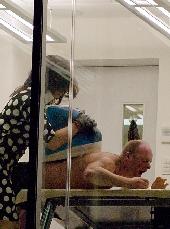SITE GUIDE
SEARCH
REVIEWS
REVIEW ARCHIVES
ADVERTISING AT CURTAINUP
FEATURES
NEWS
Etcetera and
Short Term Listings
LISTINGS
Broadway
Off-Broadway
NYC Restaurants
BOOKS and CDs
OTHER PLACES
Berkshires
London
California
New Jersey
DC
Philadelphia
Elsewhere
QUOTES
TKTS
PLAYWRIGHTS' ALBUMS
LETTERS TO EDITOR
FILM
LINKS
MISCELLANEOUS
Free Updates
Masthead
Writing for Us
A CurtainUp  London Review
London Review
 London Review
London ReviewContains Violence
|
Watch him and remember you are him. Watch him struggle to survive.—Michael
|

Hannah Ringham and Nigel Barrett
(Photo: Simon Kane) |
Strongly reminiscent of Hitchcock's Rear Window, this thriller is acted out in a plausibly mundane setting. As the menace accumulates, the audience begin to experience a sense of dreadful helplessness and even complicity in the horrific events happening before them.
With believable realism, the audience see three lone, after hours office occupants act out the secret farce of modern working life: that no one is actually working or indeed doing very much at all. There is one woman (Hannah Ringham) blowing up balloons for a party with no guests and quaffing tequila, one man (Nigel Barrett) on the point of resignation from his job and who receives foul-mouthed, threatening phone calls and one hot desker (Neil Edmond), a "roaming nomad" of the office and who is obviously yet endearingly a spare part in the organisation. And finally, there is the host (Simon Kane) who inducts the audience into the world of voyeurism, first explaining how to use the headphones and who then becomes part of the action. In one chilling moment, we realise he is more than a theatre usher, when he puts away his microphone, but continues to speak straight into the audience's ear.
When he declares "I am a voice in your head", there is nothing to contradict him and it is soon obvious that the sound effects will be a star in themselves. The audience hear the sounds of the distant offices with the clarity of close proximity. We hear every word spoken, every footstep, every computer key tapped, every sip of water gulped and even beating hearts. The reality of this technical wizardry is breathtaking and, when one of the characters' stomach rumbles, the audience squirm as if it was their own. This means that, although the audience feels removed from the action in terms of distance and unobtrusiveness, there is a simultaneous sense of absolute immersion in the characters' lives.
This is one of the strengths of the production, accompanied by the personal exclusivity of the experience which is in some ways similar to cinema. Also, outside of the normal forum, this play is stripped of any sense of theatre's artifice. Admittedly, the play starts very slowly, but this is part of the naturalism: to convince the audience they are watching a normal situation, nothing can happen for a certain length of time. Also, this adds to the suspense and the horror of the withheld violence when it is finally released. Moreover, with the formidably insinuating sound effects, the violence is painfully intimate and graphic.
Executed with dry, quirky humour (some of which is unfortunately lost due to the distance), this show baffles any attempt at categorisation. A wholly ingenious idea for site-specific theatre, Contains Violence looks at infiltration, observation and collusion, as well as murder in the context of a certain apathetic aimlessness of daily life.
|
CONTAINS VIOLENCE
Created and directed by David Rosenberg With: Nigel Barrett, Neil Edmond, Simon Kane, Hannah Ringham Designer: Lizzie Clachan Composers and Sound Designers: Max and Ben Ringham Video Designer: Susanne Dietz A Lyric Hammersmith production, developed at the shunt lounge Running time: Seventy minutes with no interval Box Office: 0871 22 117 29 Booking to 10th May 2008 Reviewed by Charlotte Loveridge based on 2nd April 2008 performance at the Lyric Hammersmith, Lyric Square, King St, London W6 0QL (Tube: Hammersmith) |
|
London Theatre Tickets Lion King Tickets Billy Elliot Tickets Mighty Boosh Tickets Mamma Mia Tickets We Will Rock You Tickets Theatre Tickets |




